
Are You on An Email Blacklist? Find Out – And See How to Get Delisted
For many marketers and business owners, being added to an email blacklist is a terrible nuisance. It affects your sender reputation, deliverability, and overall email marketing performance. Plus, it can be hard to recover from such an episode and get back on track.
The best way to approach the issue of email blacklists? Being proactive about your sender reputation is key. However, if your domain or IP do get added to a blacklist, there are easy ways to find out and get delisted.
SaaS content marketer Mark Quadros, our guest on the blog today, will show you how.
How do you end up on a blacklist?
Despite the steady growth of other digital marketing platforms, email continues to be a powerful avenue for brands to promote their products and services and build a stronger relationship with their customers.
On average, email generates $42 for every $1 spent, while some companies have been able to attain ROIs greater than $70 for every $1 investment.
More than 59% of marketers claim email is the biggest ROI channel, 80% believe that email marketing increases customer retention, and 87% consider email to be their top organic distribution channel.
As wonderful as all these benefits are, you won’t be able to enjoy them if you don’t have a strong sender reputation. Without it, your domain or IP could end up on an email blacklist and your campaigns will never get to your target audience’s inbox.
To ensure that your email reputation remains positive, you need to consistently monitor your delivery rates and fix potential problems before they cause serious trouble.
In this post, we’re going to cover what you need to know about:
- email blacklists
- how to determine if you’ve been blacklisted
- what you can do to remedy the situation.
You’ll also learn the best practices to avoid ending up in the spam folder and hurting the growth and revenue of your business.

What are email blacklists?
Email blacklists are databases that monitor domains and IP addresses to determine and block those who send spam emails. The purpose of blacklists is to ensure that fraudulent, harmful, misleading, or illegitimate emails don’t make their way to people’s mailboxes.
Who maintains email blacklists?
Internet service providers (ISPs), free email providers like Gmail and Yahoo and anti-spam organizations.
Email blacklists are necessary to prevent spam
Reports show that about 45% of all emails come from untrustworthy sources and are considered spam. Blacklisting services are the good Samaritans – the guardians standing between us and a flood of unwanted, suspicious messages.
There are different kinds of blacklists and each one has its platform-specific way of categorizing emails as spam. However, we can group email blacklists into three main types:
- Private blacklists — They’re internal blacklists maintained by Internet service providers (ISPs). For instance, Yahoo and Gmail have private blacklists with internal algorithms and spam filters to determine whether an email should be rejected, flagged as spam, or delivered to people’s primary inboxes.
- Public blacklists — These are publicly available blacklists that anyone can check for free.
- Enterprise spam firewalls — These are usually maintained by corporate IT departments such as Ironport, McAfee, and Barracuda.
If you end up on any of these email blacklists, you can say goodbye to your marketing campaigns reaching your audience and producing the desired results.
How do email blacklists work?
When you send an email, it goes to an ISP receiver first, where it’ll be evaluated against a list of blacklisted IP and domain addresses. If you’re found on the list, your email will be rejected outright.
If not, your email will then be analyzed by the ISP’s spam filters to decide if it’s legitimate or not. Once you pass the test, your email will be delivered to your subscriber’s inbox.
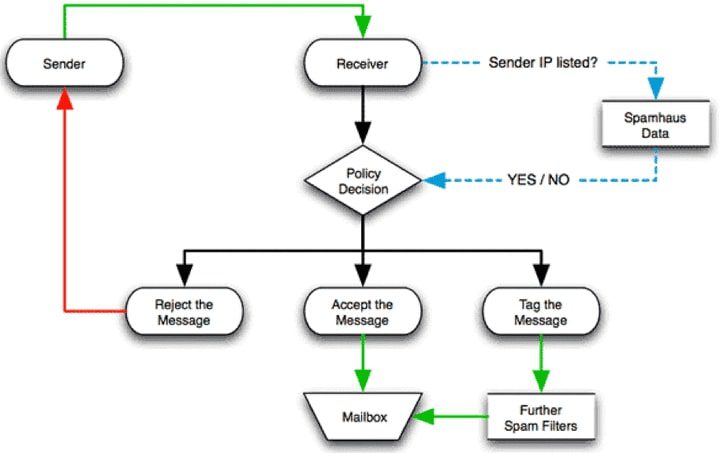
However, if the ISP notices that your IP address has a habit of sending spammy content or sending emails to spam traps, your message will go to the junk folder.
As I mentioned earlier, every ISP has its policies and criteria for blacklisting emails.
But here are some of the reasons they may make an email pariah of you.
High email volume and frequency
When calculating your sender reputation score, ISPs will look at your email history. If they notice you send too many emails, or see a sudden increase in email volume, they’re likely to find your activities suspicious and put you on a blacklist.
Related: How to block unwanted emails
Poor list hygiene
If you keep sending emails to inactive or incorrect email addresses, it’s a sign that you’re not growing your email list organically or ethically. Bad email hygiene is one of the most common reasons senders land on email blacklists.
Hitting spam traps
Speaking of list hygiene, spam traps are some of the riskiest email addresses that could be lurking in your list. When your emails land in spam traps, that tells ISPs and blacklist providers that your database lacks maintenance.
Inferior email content
Using improper formatting, caps lock, misleading subject lines, too many exclamation marks, colored fonts, or keywords like “money-back guarantee,” “buy now,” or “free” signals that you’re sending poor, blacklist-worthy content.
Hacker activities
If hackers gained access to your email domain or IP and are using it to send illegitimate messages without your knowledge, you could get blacklisted for their actions.
Bad email management practices
If people unsubscribe and you continue sending them emails, you’re likely to get blacklisted. Ignoring email best practices is not the best way to ensure your best delivery rates.
One too many spam complaints
Getting a spam complaint once in a while is perfectly normal because you can’t please everyone. But once you cross the acceptable limit – one complaint for every 1,000 emails – your chances of ending up on a blacklist increase.
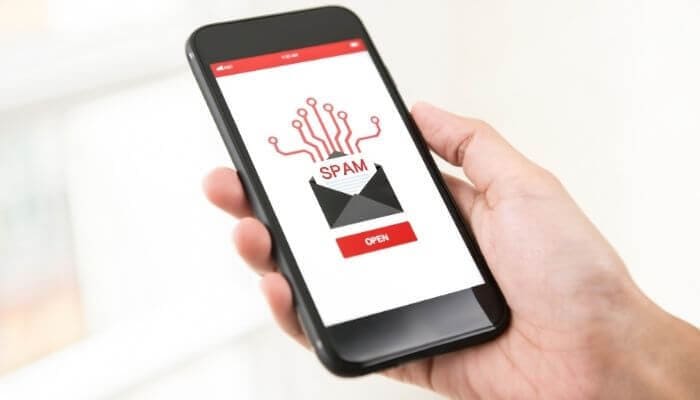
Consequences of being blacklisted
Your email reputation is like your credit score for authenticity and trust. It’s what tells ISPs that your messages are legitimate. So when your reputation score takes a hit and you find yourself on a blacklist – or vice versa – it means you’re doing something wrong.
Getting blacklisted can negatively impact your business. It can damage your reputation and make it harder for you to communicate with customers, prospects, and generate leads. Instead of your campaigns reaching your target audience, they’ll get blocked or rerouted to spam folders, which means no ROI for you.
If your subscribers can’t see your marketing messages, it’ll be difficult to nurture and encourage them to patronize your brand. This means your open rate and click-through rate will decline and cause your website traffic to drop as well.
Also, you’ll generate fewer conversions, which could hinder your company’s growth or cripple your business completely.
Is my email blacklisted? Here’s how to find out
Low delivery rates, high bounce rates, and poor website traffic are usually indicators of blacklisting. Sometimes, you might get an error message from the ISP informing you that your domain or IP has been blacklisted.
However, you can run blacklist checks regularly and quickly fix the underlying issue. If you find out you’re on a blacklist, you can get delisted before it brings your email marketing operations to a halt.
Follow these simple steps to find out your blacklist status.
Check your reputation score
Tools like Glockapps, Mail-Tester, Senderscore, and Reputation Authority can analyze your email to see if there are any issues or spammy activities you need to take care of. They can also tell you whether an ISP has flagged your domain or IP has been flagged as suspicious.
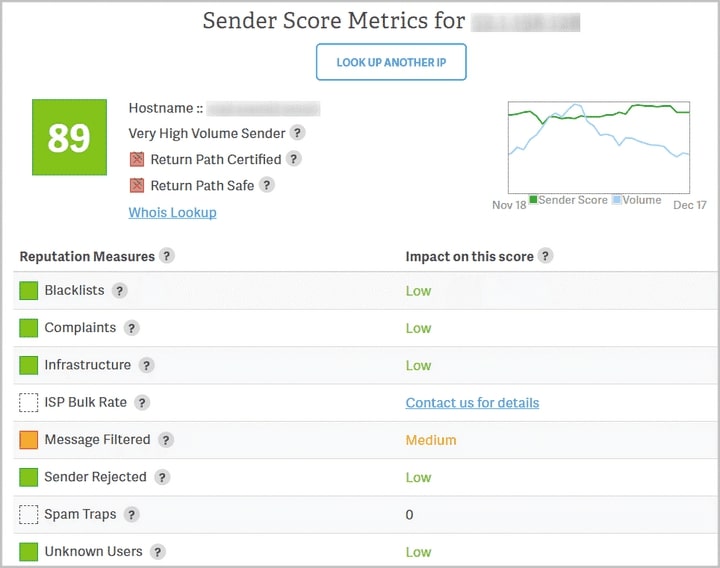
Search popular blacklist sites
You can visit the websites of common blacklist providers and browse through their databases to see if your IP/domain is listed on it. Here are some platforms where you can check your blacklist status:
- SURBL
- Invaluement
- Spamhaus
- MultiRBL
- Spamcop
- Barracuda
- MXToolBox
- Cisco/Ironport
Use the ZeroBounce email blacklist monitoring tool
Checking different blacklists manually can take you a lot of time and energy. Also, there are hundreds of lists out there, so you may not be able to cover them all.
Fortunately, there’s a simple and convenient way to find out whether your domain or IP are on any lists: our blacklist monitoring tool.
Just log into your ZeroBounce account and go to the “Blacklist Monitoring” section. You’ll see it in your dashboard, on the left side.
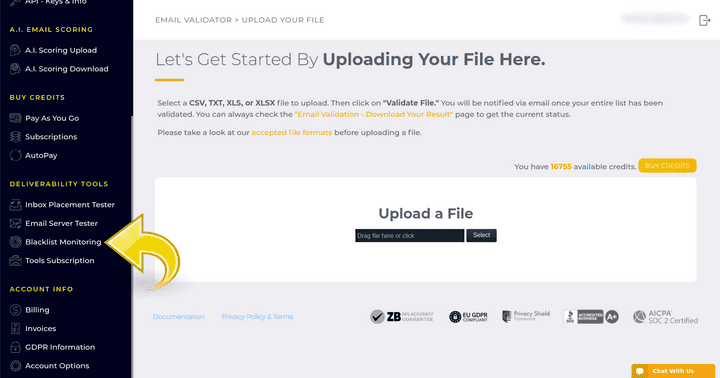
Once you’re there, follow the instructions to set up your monitor. ZeroBounce checks your status across more than 200 blacklist servers at once.
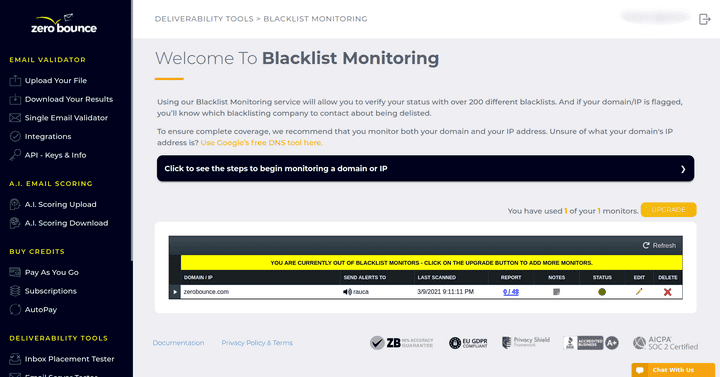
If your domain or IP address turn up, ZeroBounce will alert you. What’s more, it’ll tell you the exact blacklist provider that flagged you so you can reach out to them about getting delisted.
How to get off an email blacklist
Removing your IP address or domain from an email blacklist usually requires you to:
- submit a request to the blacklist provider
- fill out a form
- take action to improve your email strategy
- and ensure you don’t get blacklisted again in the future.
How to reduce the risk of being blacklisted
Rebuilding your reputation after you’ve been blacklisted can take a while, so do your best to stay away from any activity that could land you in trouble. This will not only decrease your chances of getting blacklisted, but it’ll also maximize the effectiveness of your campaigns.
To protect your brand and help you avoid the treacherous waters of email blacklisting and deliverability issues, try to keep these things in mind.
Never buy email lists
These lists are usually filled with spam traps and forged addresses. Focus on building your email list yourself, so you can be sure you’re sending messages to real people. Opt-in is the only healthy way to build a list.
Send emails to confirmed opt-ins only
Always send a confirmation email to each new subscriber to confirm their intent to sign up and make sure they’ve provided a valid address. Using double opt-in is a good way to reduce the number of bad contacts in your list.
Keep your server safe and clean
Malicious programs can take over your IP address/domain to send spam emails – which could get you blacklisted. So constantly update your security protocols to make sure your server is free from bots and malware.
Purge bounced and inactive addresses from your list
Any subscriber that has not opened your emails in six months shouldn’t be on your list anymore. They either don’t care for your messages or their address is no longer in use.
Don’t use spammy words
Avoid selling directly to your audience or using forced marketing lingo and only send professional, well-designed emails at all times.
Respect unsubscribers’ wishes
This is a hard rule: you must include an unsubscribe link in every email. When people opt out of receiving your messages, don’t keep hounding them. Just remove them from your list.
Never send mass emails from an ISP
Webmail services like Gmail and Yahoo are built for personal use, so using them to send mass emails will trigger suspicion. For mass emails, use dedicated email marketing providers like Mailchimp and ActiveCampaign.
Use a reputable email service provider (ESP)
Speaking of email providers: their sending reputation has a strong impact on yours. Before you sign up for a new ESP, ask questions and make sure they follow best practices.
Avoid fluctuating email volumes
If you want to increase your email frequency or volume, start small and keep raising it gradually. You can find more information about warming up your IP in our free email deliverability guide.
Keep an eye on your sender reputation
Monitor your sender reputation regularly to see how well you’re performing or whether there’s any suspicious activity on your domain.
Be proactive with your email reputation
Your email campaigns have to reach your subscribers’ inboxes before they can have any kind of impact. Ending up on a blacklist will only take you further away from your marketing goals. One of the best ways to avoid this is to send useful and valuable content to your audience and to practice good email etiquette all the time.
Author bio: Mark Quadros is a SaaS content marketer that helps brands create and distribute rad content. He contributes to several authoritative blogs like HubSpot Sales, CoSchedule, and Foundr. Connect with him via LinkedIn and Twitter.






